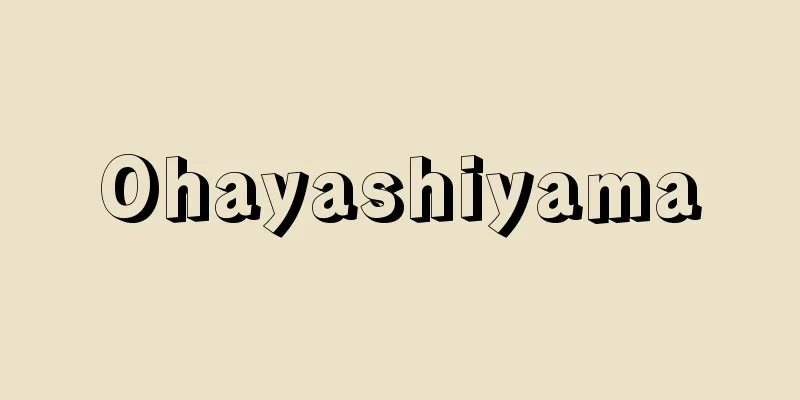Legend - Legend

|
A type of folk tale or oral literature. In Japan, the words "iitsutae" or "iware" have been used since ancient times to refer to this type of thing. From these expressions, it seems that the subject matter originally referred to events believed to be true, and even the stories themselves related to them. From this perspective, it basically referred to things that existed only among the people and were passed down without the mediation of writing. It was an oral linguistic tradition in a non-literate society. It is thought that this is what originally differentiated it from myths. Of course, stories of this type also exist in other countries. These are the "folk stories" that China calls. Also, there is the word legend in English, légende in French, and sage in German. Therefore, there have been many attempts to examine the content and define the concept by comparing and contrasting with such foreign languages. However, there are already many incompatible parts in the meanings and contents that each word has historically contained, and it is difficult to expect a perfect agreement with these words. Nevertheless, there are some things that we can point out that we share in common and that cannot be overlooked: characteristics. [Junichi Nomura] CharacteristicsThese kinds of stories all once had a history or a process that was believed to be true. If the story itself had been suspected from the beginning to be a fabrication or contrary to the facts, it would have lost the opportunity to be passed down. Therefore, the further back the story goes, such as the creation of mountains and lakes, or the arrival of grains, the closer the story itself is to myth, and the distinction between the two becomes extremely confusing. Next, in order to prove the historical nature of this kind of story, or that it was true, they prepare commemorative items or events that actually occurred in the past to provide supporting evidence. Examples of this are the grave of Nitta Yoshisada's head or the Kasagake cherry tree of Saigyo Hoshi. They directly secure and preserve things related to the story, and actively use them as proof of the existence of the facts. They try to make it concrete. As a result, the stories were often told in close tandem with historical facts, and sought to acquire a life of time. For this reason, when telling these kinds of stories, there were cases where they were clearly told as a complete story, and cases where they were limited to a very simple explanation based on the situation at hand, that is, on the subject of the story. So, to summarize the above characteristics, first of all, there was a sincere and simple attitude of the people who supported these stories. They had faith and trust. This can be seen as faith or religiosity. Secondly, the stories were always related to historical events, and credibility was emphasized. For this reason, evidence to confirm the facts was always needed. This can be seen as reality and history. Thirdly, the stories were independent stories, with ups and downs, and sometimes they had a beginning, development, twist and conclusion, and sometimes they only briefly explained the origin of the things in front of them. In other words, the stories were always free to be long or short, and to expand or contract depending on the time and situation. Therefore, this can be seen as a lack of a unified style, that is, an amorphous tradition. These characteristics are not necessarily all common principles or conditions under the circumstances of each country. In reality, however, when these extracted characteristics are compared and collated with other groups of folk tales or oral literature, such as folk tales, their distinctive features are likely to become even more apparent and revealed. [Junichi Nomura] Differences from the old taleFolktales were originally highly narrative in nature, relying on imagination and fiction. Everyone knows this beforehand. Therefore, it is no longer acceptable to expect truth or reality from the contents of folktales. Therefore, from the beginning, there was no need for mementos or events to prove the basis of the story. Furthermore, when folktales were transmitted and enjoyed, there was originally a set opening phrase and a corresponding closing phrase. Examples include "Ichigo, sakke" for "Tonto mukashi ga ga gero" and "Toppin karari" for "Mugashi, mugashi". This means that the style of storytelling was firmly established. Therefore, as a result, arbitrary expansion or omission of the content was almost impossible. This was the normal state of affairs. Due to the above-mentioned realities, it can be said that the difference between folktales and legends is now definitive. [Junichi Nomura] Research HistoryFocusing on this difference between the two, the German Brothers Grimm J. & W. Grimm argued in the early 19th century that "fairy tales are poetic, while legends are historical." They were the first to attempt to define legends or define their concepts. Meanwhile, Ueda Bin was the first Japanese researcher to express this view. He was the first to translate folklore and use the term "zokusetu-gaku" (fairy tales and other stories) for it. He also said that "zokusetu-gaku is not just the study of ancient tales and stories such as fairy tales, but can also examine and investigate the totality of all legends that exist in the minds of the people at a certain time." Regarding the difference between legends, myths, and fairy tales, he first stated, "There are two types of stories: (1) stories for entertainment, and (2) stories that are believed to be true." He then went on to say, "As for the distinction between fairy tales and these two, the gods and heroes that appear in ancient myths have definite names, are often associated with definite lands, and are said to have actually existed in this world in the past. In contrast, the world of fairy tales is all vague. Many of the names of the people are not fixed, and it is impossible to say where or who they are." In this light, Ueda's remark here can be evaluated as extremely appropriate and accurate, even at an early time. However, that was the end of Ueda Bin's statement, and after this, the concrete classification and organization of legends in Japan and the identification of the associated problems had to await the dawn and rise of folklore studies itself, just like in other developed countries. [Junichi Nomura] ClassificationTakagi Toshio (1876-1922) left a legacy that cannot be overlooked in the history of research. Takagi's interest in legends was earlier than anyone else's, and from the very beginning he aimed to systematize them. Specifically, in 1913 (Taisho 2), Takagi selected over 250 stories from the hundreds of folk legends and fairy tales collected from all over the country by the Tokyo Asahi Shimbun Company, and published the "Collection of Japanese Legends." In this collection, Japanese legends were classified into 23 groups based on their form and motif. These were further divided into Class A, Class B, and Class C, which were further subdivided into Classes (1), (2), and (3), and further subdivided into Classes (A), (B), and (C). The 23 groups that were attempted were as follows: [1] explanatory mythological legends, [2] the legend of the giant and the two mountains' back race, [3] the ninety-nine legends, [4] tree legends, [5] stone legends, [6] castle ruins and rich man legends, [7] the legend of the Golden Rooster Curse, [8] the legend of the bowl lending hole, [9] the legend of the escape hole, [10] the legend of the sunken bell, [11] aquatic mythological legends, [12] the dog god and humans [13] Wolf legends, [14] Legends of wives' disputes, [15] Legends of a ship bridge, [16] Legends of divine marriage, [17] Legends of the righteous dog mound and the defeat of the monkey god, [18] Legends of good luck, [19] Folk beliefs (curses, vengeful spirits, Ubagai pond, etc.), [20] Legends of human sacrifice, [21] Folk tales, [22] Legends of nature, [23] Legends of Huai Tensho. Regarding the above classification, Takagi wrote in his "Explanation" that "The various headings in the classification table of contents are most likely the author's invention, so I have decided to add an explanation for each in the explanatory section. As for the structure of this book as a whole, I intend that the classification explains it itself, so I will not say anything more." This shows his pride as a pioneer. However, there are some parts that are a little confusing in terms of the distinction between myths and his stories, and as can be seen in section [22], there are also some parts that are extremely ambiguous in terms of the distinction between his stories and what are now called "animal folk tales." Around the same time, Kunio Yanagita also had a deep interest in classifying and organizing these legends from an early stage. In order to directly subject these kinds of stories, which are widely circulated among the general public, to academic study and to incorporate them into the field of humanities, the immediate task was to systematize them. For this reason, Yanagita actually began working on this kind of project. In a letter to Minakata Kumagusu in June 1911 (Meiji 44), he wrote, "Recently I have been planning to write a book that collects legends," and then in October he went on to reveal the specific contents of the book, writing as follows: "The order is almost the same as that of "Taiyo", so I am planning to call the book "Seventeen Legends". Kappa Komahiki, The Hoof of the Divine Horse, Daida the Priest, Uba God, Enoki's Staff, Yaobikuni, The Glory of the Rich Man, The Fall of the Rich Man, The Morning Sun, The Evening Sun, The Golden Chicken, The Hidden Village, The Lending of a Bowl, The Magic Mallet, The Messenger of a Letter, The Birth of a Stone, The Growth of a Stone, The Water of an Inkstone. I intend to collect about 300 stories from the early modern period by connecting these stories. Many of these stories will have spread to the West through Buddhist scriptures, but I would like to clarify what kind of transformations they have undergone in Japan." However, the plan at that time was not realized and was abandoned halfway through. However, after "Questions and Answers with the Stone God" (1910), Yanagita continued his research in such works as "Stories that Helped the Gods" (1920), "Legends" (1940), "Words of the Trees and Stones" (1942), and even "The Sacred Tree Chapter" (1953). Eventually, he came to his own unique view and realization that "No matter how deeply related the content may be, from the perspective of their origin, legends are not stories. One cannot help but feel that what has been handed down in the world are events, not words" ("Thoughts on the History of Oral Literature"). This was most clearly shown in "A Vocabulary of Japanese Legends" (1950), which was divided into six sections based on the central subject. These are the "Trees section" (trees, bracken, potatoes, rapeseed, silver grass, thatch, reeds), the "Stones and rocks section" (stones and rocks), the "Water section" (bridges, clear water, wells, hot springs, ponds, rivers, fords, dams, pools, waterfalls, water holes), the "Mounds section" (mounds), the "Slopes and passes section" (slope, pass, mountain, valley, cave, mansion, castle ruins), and the "Shrine section" (Jizo, Yakushi, Kannon, Fudo). [Junichi Nomura] assignmentIn this way, Yanagita Kunio's attitude towards legends is extremely narrow, prosaic and matter-of-fact compared to Takagi Toshio's. It is clear that he understood it as "a thing, not words". However, even if Yanagita was object-centered, even if we were to accept it as the "Koshikakeishi" in the "Stones and Rocks" section, or the "Sugatami-no-I" in the "Wells" section, would that be enough to convey to people the contents of the ancient "story" or "legend" related to it? Of course, the pointing out of the thing in "Mei" is an essential factor. On the other hand, it is merely a factor in the story, not the story itself. However, weren't people who are usually interested in legends hoping for news of Kobo Daishi's tour of various provinces related to the "Koshikakeishi", and also stories of Yoshitsune and Benkei? Considering this, it is hard to deny the impression that Yanagita Kunio's proposal here overlooks the character of this kind of story as folk tales or oral literature, in other words, the aspect of linguistic tradition. Of course, Yanagita's method is based on the standpoint of folklore, and it is unavoidable if it is an attempt to intentionally reject the literary nature of legends. In any case, the most fundamental task in the study of legends in Japan is the classification and organization itself, which has yet to be determined. The same thing can be said from a global perspective, and at the International Conference on Oral Literature held from 1961 to 1963, a new proposal for a classification of legends was presented, but it has yet to gain full support. [Junichi Nomura] "Revised edition of 'Japanese Legends Vocabulary' supervised by Yanagita Kunio (1971, Japan Broadcasting Publishing Association)" ▽ "'Japanese Legends', all 50 volumes, written by Takeda Shizuzumi and others (1976-80, Kadokawa Shoten)" ▽ "'Folktales of the World: Commentary', written by Ozawa Toshio (1978, Gyosei)" ▽ "'Legends of the World', all 10 volumes, edited by Iide Michio (1979-80, Gyosei)" ▽ "'Japanese Legends Encyclopedia', 15 volumes and 1 supplementary volume, edited by Nomura Junichi and others (1982-90, Mizuumi Shobo)" ▽ "'Hometown Legends', all 10 volumes, supervised by Ito Seiji (1989-90, Gyosei)" ▽ "'Japanese Legends', edited by Yamada Norio and written by Takagi Toshio (1990, Hobunkan Publishing)" ▽ "'Myths and Legends of the World', written by Yoshida Atsuhiko and others Complete Commentary, revised and expanded edition (2002, Jiyū Kokuminsha) ▽ "Japanese Legends, by Kunio Yanagita (Shincho Bunko)" ▽ "The World of Legends and Popular Beliefs: A Study of Oral Literature 2, by Toru Tsunemitsu (Kadokawa Sophia Bunko)" [References] | | | | | | | | | | | | | | | | | Folktale | | Sacrifice | | | | Folklore | | |Source: Shogakukan Encyclopedia Nipponica About Encyclopedia Nipponica Information | Legend |
|
民間説話あるいは口承文芸の一類。この種のものをいうことばに、わが国には古くから「いいつたえ」もしくは「いわれ」の語があった。こうした表現からみて、その対象は元来が真実と信じられる事件、さらにはそれにまつわる話そのものを称していたとみられる。このような情況からみて、基本的にはそれはあくまでも民間にあって、しかも文字を媒介せずに伝えられてきたものをいった。無文字社会における口頭の言語伝承であった。神話との違いは、もともとそうしたところにあったと考えられる。こうした類(たぐい)の話は、もちろん外国にも存する。中国でいう「民間故事」がそうである。また英語はlegend、フランス語にはlégende、ドイツ語にはSageの語がある。そこで、従来からこのような外国語との比較・対照による内容の吟味と概念規定は、しばしば試みられてきた。しかし、それぞれの語が歴史的にもそこに抱え込んできた意味・内容には、すでに相いれない部分がかなりあって、これらのことばとの完全な一致を期待するのは困難である。しかしそれにもかかわらず、その間、互いに共通して擁しているそこでのありようには、これまた見過ごすことのできない事実がいくつか指摘しうる。それは特性である。 [野村純一] 特性こうした類の話は、かつての日に、いずれもその内容が事実であったと信じられた歴史、もしくはそうした経過をもっていた。最初から話そのものを虚構であるとか、事実に反するのではないかなどと疑ったのでは、伝えられるきっかけを失っていたということである。したがって、山や湖の創成とか、あるいは穀物の渡来を説くとかのように、話の内容が原古にさかのぼればのぼるほど、話そのもののありようは神話のそれに接近し、両者の区別はきわめて紛らわしい状態を示してくる。ついで、この種の話はそこでの歴史性、いうなればそれが事実であったことの証明として、実際に過去に惹起(じゃっき)した事件やできごとの傍証を求めるべく、記念品もしくはそこでの事跡を用意する。新田義貞(にったよしさだ)の首塚であるとか、西行(さいぎょう)法師の笠掛(かさがけ)桜とかいうのがこれで、話に関連する事物を直接確保・保存して、積極的に事実の存在証明にする。具体化を図るわけである。これによって、そこでの話はしばしば歴史的事実に寄り添って伝えられ、その時間的生命を獲得しようとした。これがために、こうした類の話を伝えるに際しては、明らかにこれを完結した一編の物語としていう場合と、一方にはまた、眼前の事態、つまりは属目(しょくもく)の事物に即してごく簡単に説明するにとどまってしまう場合とがあった。 そこでいま、改めて以上の特性を要約するならば、そこにはまず第一に、こうした話に向けて、これを支持する人々の真摯(しんし)・素朴な心持ちがあった。信心があり信頼があった。これを信仰あるいは宗教性としてみることができる。第二に、話は求めてつねに歴史上のできごとにかかわって説かれようとし、信憑(しんぴょう)性が重視されていた。それがために、怠りなく事実追認の証拠品を必要とした。これを現実性、歴史性としてみる。第三に、話は独立した一編の物語として、起伏に富み起承転結を心得ている場合と、他方、目の前にある事物の由来をわずかに説く場合とがあった。いうなれば、話は時と場合によって長短、伸縮は常時自在であった。したがって、これを統一された様式の欠如、つまりは不定型の伝承とみることができる。これらの特性が、それぞれの国の状況下にあっては、かならずしもすべて共通の原則とか条件であるとするのではない。しかし実際には、抽出されたこうした性格は、ひるがえって民間説話もしくは口承文芸の他のグループ、たとえば昔話に比較・照合したときに、そこでの特色はよりいっそう顕在化し、露呈してくるものと思われる。 [野村純一] 昔話との相違昔話は、そもそもが空想力や虚構性にゆだねられた、物語性の強い内容であった。これはだれしもがあらかじめ承知している。したがって、昔話の内容に向けてそこでの真実もしくは現実性を期待するのはすでに認められない。それゆえ、話の根拠を証明する記念品や事跡は当初から必要としなかった。さらに昔話は、その伝達と享受に際しては、もともと定められた語り始めの句と、それに対応する語り収めの句が存在した。「とんとむかしがあったげど」に対する「いっちご、さっけ」とか、「むがし、むがし」に対する「とっぴんからりん」などがそれである。これは要するに物語の伝承様式はきちんと確定していたということである。それがため、結果として、そこでの恣意(しい)的な中身の伸縮や省略はほとんどなしがたい。これが常態である。以上、このような実情によって、この昔話と伝説との違いはもはや決定的であるといってよい。 [野村純一] 研究史そこで、両者のこうした相違に着目して、19世紀初頭にドイツのグリム兄弟J. & W. Grimmは「昔話は詩的であり、伝説は歴史的である」と説いた。伝説の定義もしくはその概念規定について、もっとも早くにそれを試みたのはこの兄弟であった。一方、わが国の研究者で初めてその種の見解を示したのは上田敏(びん)であった。Folkloreを訳して、これに、「俗説学」の語を用いたのは上田敏が最初であった。それとともに彼は「俗説学は単にお伽噺(とぎばなし)のやうな古来のハナシ又(また)モノガタリのみを研究するのでは無く、一定時に於(お)ける一民衆の心に存するあらゆるイヒツタヘの総体を吟味し取り調べてよい」とした。そのうえで、さらに伝説・神話・お伽噺の差異については、まず「一体ハナシには(1)娯楽の為(ため)にするハナシと(2)真実と信じるハナシとがある」と言い置いたあと、「お伽噺とこれら二者の区別如何(いかん)といふに、古伝神話に現はれる神明、英雄等は、一定の名称を有(も)ち、多くは一定の土地に関係して、嘗(か)つて実際この世に存在してゐたとしてある。之(これ)に反して、お伽噺の世界はすべて漠としてゐる。今は昔とか、昔々あつたとさとかいふばかり、人物の名も多く定まつてゐず、何処(どこ)とも誰(だれ)とも、全く当がない」と述べた。こうしてみると、ここでの上田の指摘は、早い時機にあってきわめて適切、的確であったと評しうる。ただし、上田敏のその発言はそこまでで、このあと、わが国に行われる伝説の具体的な分類、整理とそれに伴う問題点の摘出は、他の先進諸国同様、民俗学そのものの黎明(れいめい)と勃興(ぼっこう)のときを待たなければならなかった。 [野村純一] 分類研究史上見逃すことのできぬ業績を残したのは高木敏雄(としお)(1876―1922)である。伝説に向ける高木の関心は他に先んじて早く、しかも彼は当初からこれの体系化を目ざしていた。具体的には1913年(大正2)東京朝日新聞社が全国から募集した民間伝説・童話数百件のなかから高木は250余編を選出し、そのうえで『日本伝説集』を上梓(じょうし)した。そこでは形式、モチーフを基準にして、わが国の伝説が23群に分類された。それはまた甲乙丙に分けられ、なおその下位区分として(1)(2)(3)、さらに(イ)(ロ)(ハ)というぐあいに細分化されたものであった。試みられた23群は次のとおりである。〔1〕説明神話的伝説、〔2〕巨人・両岳背競伝説、〔3〕九十九伝説、〔4〕樹木伝説、〔5〕石伝説、〔6〕城跡・長者伝説、〔7〕金鶏呪咀(じゅそ)伝説、〔8〕椀貸穴(わんかしあな)伝説、〔9〕抜穴(ぬけあな)伝説、〔10〕沈鐘(ちんしょう)伝説、〔11〕水界神話的伝説、〔12〕犬神(いぬがみ)・人狼(じんろう)伝説、〔13〕英雄伝説、〔14〕妻争伝説、〔15〕船橋伝説、〔16〕神婚伝説、〔17〕義犬塚・猿神退治伝説、〔18〕縁起伝説、〔19〕民間信仰(呪咀(じゅそ)・怨霊(おんりょう)・姥池(うばがいけ)など)、〔20〕人柱伝説、〔21〕民間説話、〔22〕天然伝説、〔23〕淮天照伝説。ところで、前記の分類について高木はその「凡例」のなかで「分類目次中の種々の名目は、十中八九まで著者の考案に成つてゐるのであるから、解説の条に於(おい)て、それぞれ説明を加へることにした。尚此(なおこの)書全体の組立は、分類が自ら説明してゐる積りであるから、別に何も云(い)はぬ」と記していた。先覚者としての自負のほどがうかがえる。ただし、神話との区分にいささか紛らわしい部分があり、さらには〔22〕の項にみられるように、現在いうところの「動物昔話」との区分にきわめてあいまいな部分が存する。 これに前後して、柳田国男(やなぎたくにお)も早くからその分類と整理には深い関心を抱いていた。広く民間に流布するこの種の話を直接学問の対象に据え、これを人文科学の分野に繰り入れていくためには、なによりもまずその体系化が当面の課題であったからである。そのため、柳田は実際にその種の作業を手がけていた。1911年(明治44)6月、南方熊楠(みなかたくまぐす)あての書簡に「このごろ小生も伝説をあつめたる本を書かんと企ており候」と述べたあと、10月には続けてその具体的内容を明かして、次のように記している。「順序はほぼ『太陽』に掲げ候総目により『伝説十七種』という書名のつもりに候。川童駒引(かっぱこまひき) 神馬の蹄(ひづめ) ダイダ法師 姥(うば)神 榎の杖(えのきのつえ) 八百比丘尼(びくに) 長者栄花 長者没落 朝日夕日 金の鶏(とり) 隠れ里 椀貸 打出小槌(うちでのこづち) 手紙の使 石誕生 石生長 硯(すずり)の水 これだけをほぼ相互の連絡をとり近世の話三百内外あつめ置くつもりに候。いずれ多くは仏経を中間にして西洋にも行きわたりおる話に候わんが、小生はもっぱら日本にていかなる変形を閲(えつ)せしかを明らかにしたく考えおり候」。しかし、このときの構想は実現に至らず、途中で放擲(ほうてき)された。しかるに柳田は『石神問答』(1910)以後、『神を助けた話』(1920)、『伝説』(1940)、『木思石語』(1942)、さらには『神樹篇(へん)』(1953)といったぐあいに研究を重ね、やがて彼は「如何(いか)に内容では縁の深いものがあらうとも、其(そ)の成立ちから見て伝説はハナシで無い。その世に伝はってゐるのはコトであって、コトバで無かったことを感ぜずには居られない」(『口承文藝(ぶんげい)史考』)とする独自の見解と認識に達した。それがもっとも端的に示されたのは『日本伝説名彙(めいい)』(1950)である。そこでは中心をなす事物に沿って6部門が設けられた。「木の部」(木・蕨(わらび)・芋・菜・薄(すすき)・茅(かや)・蘆(あし))、「石・岩の部」(石・岩)、「水の部」(橋・清水・井・湯・池・川・渡・堰(せき)・淵(ふち)・滝・水穴)、「塚の部」(塚)、「坂・峠の部」(坂・峠・山・谷・洞(ほら)・屋敷・城趾(じょうし))、「祠堂(しどう)の部」(地蔵・薬師・観音・不動)といったのがそれである。 [野村純一] 課題こうしてみると、伝説に対する柳田国男の姿勢は、高木敏雄のそれに比較してきわめて狭く、散文的であり、また即物的である。まさしく「コトであって、コトバで無かった」とする理解であったのがわかる。しかし、たとえいかに事物中心主義とはいえ、かりにこれを「石・岩の部」の「石」の「腰掛石」とか、「水の部」の「井」の「姿見の井」といったように認めたとしても、はたしてそれだけでこれにかかわる古くからの「いいつたえ」とか「いわれ」の内容を人々によく伝えることができるであろうか。もちろん『名彙』にいう事物の指摘は欠かせない要因である。しかし、反面それはあくまでも話の要因であるにすぎず、話そのものではない。けれども、通常伝説に興味と関心を抱く人々の期待は、やはりその「腰掛石」にまつわる諸国巡錫(じゅんしゃく)の弘法(こうぼう)大師の消息であり、さらにはまた義経(よしつね)や弁慶の物語ではなかったか。それを思えば、ここにみえる柳田国男の提案は、民間説話もしくは口承文芸としてのこの種の話の擁する性格、つまりは言語伝承といった面をややなおざりにしすぎたかの印象は否めない。もっとも柳田のこの方法は民俗学の立場からのそれであって、意図して伝説の文芸性を拒否した試みであるということならばやむをえない。いずれにしても、わが国にあって伝説研究の課題は、もっとも基本になるべき分類・整理そのものがまだ確定していない。同じようなことは世界的な見地からもいえるのであって、1961年から63年にかけて口承文芸の国際会議では、新たな伝説分類案が提示されたが、それとてもまだ全面的な支持を得るには至っていない。 [野村純一] 『柳田国男監修『日本伝説名彙』改版(1971・日本放送出版協会)』▽『武田静澄他著『日本の伝説』全50巻(1976~80・角川書店)』▽『小沢俊夫著『世界の民話 解説篇』(1978・ぎょうせい)』▽『飯豊道男編『世界の伝説』全10巻(1979~80・ぎょうせい)』▽『野村純一他編著『日本伝説大系』15巻・別巻1(1982~90・みずうみ書房)』▽『伊藤清司監修『ふるさとの伝説』全10巻(1989~90・ぎょうせい)』▽『山田野理夫編、高木敏雄著『日本伝説集』(1990・宝文館出版)』▽『吉田敦彦他著『世界の神話伝説 総解説』改訂増補版(2002・自由国民社)』▽『柳田国男著『日本の伝説』(新潮文庫)』▽『常光徹著『伝説と俗信の世界――口承文芸の研究2』(角川ソフィア文庫)』 [参照項目] | | | | | | | | | | | | | | | | | | | | | | | | |出典 小学館 日本大百科全書(ニッポニカ)日本大百科全書(ニッポニカ)について 情報 | 凡例 |
<<: Legendary Song - Densetsuka
>>: Country of origin - Denseki
Recommend
Old farmer synonyms - Old farmer
A farming book from the mid-Edo period. Compiled b...
Rat snake
… It is commonly found in forests, grasslands, cu...
Wiener, AS (English spelling)
…The MN and P blood types were discovered using t...
Shigeharu Nakano
Poet, critic, and novelist. Born on January 25, 1...
Carpobrotus
…There are more than 2,000 species, making them a...
Fleming's rule
There is a law that describes the direction of th...
Knoll, M.
...a device that uses electrons instead of light ...
"Kanmon Gyoki" - Kanmon Gyoki
…The entire 44 volumes of the original handwritte...
Meale, R.
...After the war, composers actively adopted 20th...
North Sakhalin Mining Company
...From this time on, the number of forced labore...
Glochidion puberum (English spelling) Glochidionpuberum
… [Morita Tatsuyoshi]. … *Some of the terminology...
Takajo [town] - Takajo
A former town in Kitamorokata District, southern M...
rif (English spelling) rif
The relationship between the villages and the nom...
Prime number - sosuu (English spelling) prime number
A natural number other than 1 that has no divisor...
Lysippos (English spelling)
A Greek sculptor from Sicyon, he was a representat...









